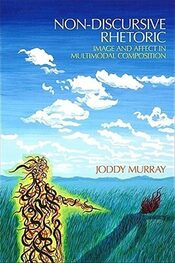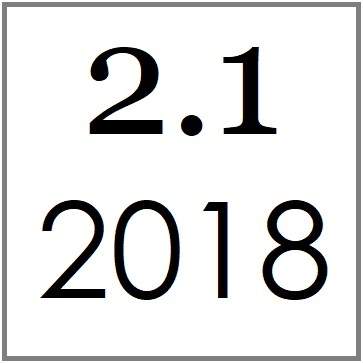RE-VIEW
Cody A. Jackson, Texas Woman's University

Murray, Joddy. Non-discursive Rhetoric: Image and Affect in Multimodal Composition. SUNY Press, 2009.
The need to review Joddy Murray’s Non-discursive Rhetoric: Image and Affect in Multimodal Composition (2009) nearly a decade after its publication may not be initially apparent. However, I deem it important to return to this influential text to explain how it may be applied through multiple academic disciplines.[1] Here, I want to cover three crucial elements of Murray’s text to remind readers of the text’s critical importance as it relates to multimodal pedagogy and its connections to cultural studies and political rhetoric. First, I look to situate the influence of the text within the field of composition studies and articulate the importance of re-viewing Murray’s text as a multidisciplinary tool for what I consider a pedagogy of resistance. Faculty and students within many disciplines (e.g. writing center scholarship, political rhetoric, visual rhetoric, communication, literature, and digital humanities) can benefit from the critical framework for multimodal modes of analysis that this text provides.
Overview
In laying the groundwork for his conception of non-discursive rhetoric, Murray structures the book into four major elements: 1) the connections between language and symbolization; 2) the importance of cognitive science and neuroscience in relation to the writing act; 3) the implications of the affective on the mind and body and, consequently, on the writing process; and 4) a potential model to “accommodate the flux between discursive and non-discursive text” (p. 9). More specifically, Murray advocates for a centering of the image and affect (the non-discursive) and the decentering of alpha-centric texts (the discursive). Rather than proposing a complete erasure of the discursive, he emphasizes that “Non-discursive texts…generally precede discursive texts” (p. 147).
What makes Murray’s text a particularly nuanced approach to the multimodal turn is his inclusion of scholarship not entirely focused on composition studies but on the sciences (Antonio Damasio), psychology (Vygotsky), and affect and composition (Brand and McLeod). Murray essentially posits that the vital connective tissue between affect, emotion, and consciousness are inextricably bound to the image. As a result of this connection, Murray argues that we must not view the image as merely a tool to enhance discursive, or alpha-centric, texts, but as a generative process through which both our discursive and non-discursive modes of communication come to be.
For the purposes of reaching a wider audience, I have decided to not reiterate the complex theories that Murray includes related to the self, will, and consciousness. Instead, I choose to focus markedly on Murray’s concept of the non-discursive as a type of vessel through which writers and students can reach the discursive. In Murray’s words, “[t]he non-discursive provides a path for the discursive because it is so intimately connected to consciousness and will through image itself” (p. 135). This focus draws our attention to several key points where Murray’s text corroborates his arguments regarding prevalent views of the non-discursive.
Murray writes that non-discursive rhetoric includes “extra-communicative elements” such as “the tone of an essay, the body language of an orator, [and] the color of the background of a web page” (p. 137). I agree that these elements are critical within the contexts of non-discursive rhetoric. However, the labeling of such elements as “extra-communicative” may suggest that they are somehow non-essential to the production of text. Although Murray refers to non-linguistic action to provide evidence for his connection of image, affect, and consciousness, a more in-depth explanation of the prefix “extra” would be useful for readers unfamiliar with the theoretical frameworks being applied. After all, these elements are not extra but crucial aspects of communication.
He also lays out six lessons to expand our understanding. The third lesson states that “[w]ill must be taught” and that “rhetors must be taught how to will [emphasis mine] themselves to symbolize with a particular audience in mine” (p. 155). As I read this section of the text, I made a note along the following lines: this teaching, this direction, produces discursivity itself. In other words, instruction is inherently discursive to some degree and attempts to produce a type of repetition of norms. This particular section of the text concerned me at first, but Murray addressed this concern in part by writing that “[s]tudents…must be able to become critically aware of the non-discursive elements of these texts [and] must learn how to produce and distribute non-discursive texts as well” (156).
By including elements of play and making as a rhetorical and pedagogical tool, Murray avoids potentially reinforcing the very discursive elements of communication his book disrupts. Additionally, Murray’s advocacy for a type of failure pedagogy – which he includes under the umbrella of a “[w]ill-to-improvise”—emphasizes the necessity for students and writers alike “to confront failure and play within the dark spaces of the unknown, the unuttered, the ineffable” (p. 141).
Nonetheless, as I read Murray’s text, I kept asking myself where all the images were. In all, the book contains about six images that are graphic representations of the concepts Murray is explaining within the text itself. These images are black and white, contain text, and serve to represent concepts in a logical manner (see fig. 1, p. 55). The lack of images within a book focused on uncovering the regulation of images and their place within composition is not surprising. On this point, I have two remarks. First, as Murray points out in the book, images have historically been viewed as supplemental to writing, and the use of images is highly restricted and regulated under the guise of copyright and rights. These regulatory structures contribute to the very problem Murray addresses in his text. The second remark I have in regards to Murray’s limited use of images centers on his concept of the non-discursive. By limiting the use of images in his text, he is positing an aesthetic argument parallel to the book’s main focus. The use of images is inevitable. The image is always present in the non-discursive and it forms meaning and knowledge that shapes, figures, and refigures the discursive.
Resistance Pedagogy: Possible Avenues
Murray’s more-recent scholarship on the topic of non-discursivity further provides essential context to the task of re-viewing the book and its overarching claims. In 2010, in a chapter within Greg Giberson and Thomas Moriarty’s What We Are Becoming titled “Composing Multiliteracies and Image,” Murray writes on the possibility of an undergraduate degree program that focuses on the concept of non-discursive rhetoric. Much like the language used in the book with which this review is primarily concerned, Murray emphasizes the importance of centering the degree program itself on the image. Furthermore, Murray writes that “composing through image” can serve “as a force for student empowerment, as a means to become critically aware of technology itself and its sociocultural milieu” (p. 224). In 2012, in “Symbolizing Space: Non-Discursive Composing of the Invisible,” Murray extends his concept of the non-discursive to include space: “To walk into a space is to walk into a composed text.” In essence, here he is “walking the walk,” so to speak, in regards to encompassing the multimodal and the ineffable—the text itself is a chapter that exists in both text and video format.
These two additional works by Murray contribute to what could be a larger discussion on the non-discursive that can inform what I call a pedagogy of resistance. Many of the critics citing Murray’s text are writing in composition. Cheryl Ball’s essay on the assessment of scholarly media highlights Murray’s insistence on the centering of the image (2012). Writing on metaphor and the making of stories and meaning, Kathleen Hart and John Long Jr. emphasize Murray’s image-centric approach, as well as the need to teach it because “today’s culture bombards students with non-discursive representational forms” (2011, p. 55). Michael-John De Palma writes that Murray’s work contributed to his work on transfer and composition. However, what I hope to suggest is the wide-reaching potential of Murray’s text for pedagogy studies more broadly, political rhetoric, and cultural analysis.
Scholarly Connections
Non-Discursive Rhetoric proves useful not only in teaching writing but in providing students with necessary tools for penetrating complex systems of discourse and power through lived, educational experiences. As researchers in the humanities and rhetoric, many of us may find ourselves reevaluating our pedagogical approaches in light of the current administration’s actions and rhetorical choices (e.g. “fake news,” alternative facts). I suggest that Murray’s text can inform a multidisciplinary approach to resistance pedagogy in several important ways. By “resistance pedagogy” I mean a pedagogy designed to empower students rather than to constrain them through the lens of what Freire termed the “banking concept” and a necessarily fluid system of analysis that places emphasis on teaching students how to analyze hidden layers of discourse as opposed to operating on their surfaces.
Murray’s text empowers students by placing emphasis on play, making, failure, and ineffability. Although he acknowledges the writing process as having an end-product, I believe that Murray effectively presents the writing process as a necessarily disruptive, fluid, and ever-growing network of flow, excess, and distributive power. Murray’s attempt to empower students through an open analytical process can be applied to work being done in all fields of discourse. Murray’s text also inherently questions traditional notions of what constitutes discursive forms of media. More specifically, by placing an emphasis on the non-discursive, on the emotional and affective relationship between the student or writer and the image, Murray advocates not only for a focus on the image but creates a point of entry into the evolving definition(s) of rhetoric itself.
To conclude, Non-discursive Rhetoric: Image and Affect in Multimodal Composition is a text that can, and should, speak to diverse academic fields. Given the current political climate, of which we need no reminder, Murray’s text can help faculty and students navigate these troubling political times – both inside and outside the writing classroom – by emphasizing the importance of the image and how it is constructed. The text helps students connect the image to design through scientific and philosophical means, and provides a necessarily flexible approach to the fluid process of writing. While Murray in no way presents his concept of the non-discursive as a perfect roadmap to success, his conceptualization of and emphasis on the non-discursive affords us an opportunity to consider new directions in the study of composition and culture in a multimodal world.
Endnotes
[1] In her 2012 review of Non-discursive Rhetoric, Jessica Safran, performed a chapter-by-chapter evaluation of Murray’s text. This review differs from Safran’s in that it situates the book within the contexts of works published after Murray’s book and attempts to emphasize in-detail its multi-disciplinary applications.
References
Ball, C. E. (2012). Assessing scholarly multimedia: A rhetorical genre studies approach. Technical Communication Quarterly, 21, 61-77.
DePalma, M. (2015). Tracing transfer across media: Investigating writers’ perceptions of cross-contextual and rhetorical reshaping in processes of remediation. College Composition and Communication, 66(4), 615-642.
Hart, K. R., & Long, J. H., Jr. (2011). Animal metaphors and metaphorizing animals: An integrated literacy, cognitive, and evolutionary analysis of making and partaking of stories. Evolution: Education and Outreach, 4, 52-63.
Murray, J. (2009). Non-discursive rhetoric: Image and affect in multimodal composition. Albany, NY: State University of New York Press.
Murray, J. (2010). Composing multiliteracies and image: Multimodal writing majors for a creative economy. In G. A. Giberson and T. A. Moriarty (Eds.), What we are becoming (pp. 217-224). Utah State University Press.
Murray, J. (2012). Symbolizing space: Non-discursive composing of the invisible. In D. Journet, C. Ball, and R. Trauman (Eds.), The new work of composing (n.p.). Composition Digital Press.
Safran, J. (2012). Review of Non-discursive rhetoric: Image and affect in multimodal composition, by J. Murray. Computers and Composition, 29, 2012, pp. 292-294.
